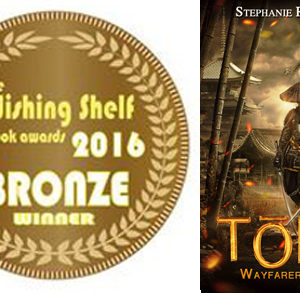 We are grateful to Mixed Book Bag for hosting a guest post on “Toru: Wayfarer Returns.” I share how I stumbled down the rabbit hole of steampunk literature through a chance invitation to a Victorian dress ball and my attempts to stretch the boundaries of the genre to fit the story I wanted to tell. I also recommend a few other books out there on the multicultural Asian Steampunk front that I personally love!
We are grateful to Mixed Book Bag for hosting a guest post on “Toru: Wayfarer Returns.” I share how I stumbled down the rabbit hole of steampunk literature through a chance invitation to a Victorian dress ball and my attempts to stretch the boundaries of the genre to fit the story I wanted to tell. I also recommend a few other books out there on the multicultural Asian Steampunk front that I personally love!
We reviewed three of those, the first and second books in Jeannie Lin’s Gunpowder Chronicles series, set in Opium Wars-era China, and a Weird West Steampunk Paranormal book by a fellow Colorado author on our publisher website. Check out those reviews of Gunpowder Alchemy and Clockwork Samurai if you are curious about steampunk set in Asia, and Blood Ties for a good Western-setting potboiler. On our to-do list is also writing up a review of Ken Liu’s “Grace of Kings” trilogy, which we loved but haven’t formally reviewed yet. Be sure to follow @sassamargot, our reviewer identity, on Twitter if you would like to hear about more books and authors we’ve reviewed and enjoyed as well as news about “Toru: Wayfarer Returns.”
Below is the guest post preserved for posterity.
Guest post: Pushing the Boundaries of Steampunk by Stephanie R. Sorensen
I stumbled into steampunk as a movement and literary genre purely accidentally, when I Googled “Victorian dress” to find something to wear to a local Victorian dress ball here in Leadville, Colorado. Up came these amazing outfits, with gears and goggles and corsets. I was entranced. One thing led to another and I wound up giving an hour-long presentation to my neighbors on Steampunks, Neo-Victorian Futurism and the Maker Movement and shocking and/or offending them by informing them they were accidental steampunks, as it is our local custom to dress up in full Victorian gear several times a year for local festivals.
Along the way, I read several dozen steampunk novels, from the works by the “founding fathers” of steampunk literature like Tim Powers, K.W. Jeters and James P. Blaylock to more recent works like Cherie Priest’s Clockwork Century. I dabbled in gaslight romances, steampunk action-adventure and steampunk alternate histories. Along the way, I came to a couple of conclusions about steampunk as literature.
First, most was set in Victorian England or the American Wild West. While this is perfectly understandable, I found it confining as a writer, for it was very well-trodden territory. One of the first questions I asked myself was “Why does a steampunk novel have to be written from the point of view of the British and Americans? What about the rest of the wide, wide world?”
Once that thought sprouted in my brain, my personal history took over. Years ago, I spent several years living in Japan, learning to speak and read Japanese, living with Japanese families and working with Japanese colleagues. I love Japan, and with a passionate but clear-eyed love that sees both faults and virtues in their unique and fascinating culture. Once I thought of setting my story in Japan, I grew very excited. The latter half of the nineteenth century was also a period of tremendous change and transformation for Japan, so a great setting for a steampunk novel, with lots of room for adventures and battles and all that good stuff.
Second, steampunk as a literary genre has evolved into something very diverse and increasingly hard to categorize. Steampunk romance, steampunk action-adventure, steampunk fantasy, steampunk alternate history…all these different flavors create very different reading experiences. This is liberating in one sense, for one might suppose that “anything goes.” It’s a treacherous liberty, though, because the writer needs to ensure the reader gets what they hope for when they open the pages of a new story. Where is that line between steampunk and something else?
I attempted to define the boundaries of steampunk literature, and came up with the following elements and conventions. Steam technology, whether realistic or fantastical. Mechanical beings and devices and gadgets, the more the better. An emphasis on a more formal and class-defined time, where formality and manners were part of the culture but could be subverted and rebelled against by putting modern female and non-white players into roles they could not have played during the real 19th century. Cool outfits and gadgets and furnishings of course, retro-19th century fashion with futuristic elements. Optimism, too. As mentioned above, a British or American setting. Adventurous derring-do. An elusive quality of concreteness, tangible materiality, social and formal constraint and simplicity that we long for and cannot find in our modern world with its virtual realities, shifting social mores and lack of rules to live by. Even the “Dress for Success” bibles of the 1980s seem hopelessly outdated and silly to us now; the constrictive corset is a wonderful metaphor for the opposite of “anything goes” that we live by today. I could list more, but these are some of the main elements in steampunk novels of whatever sub-genre.
I wanted to bring something new to steampunk, to renew these conventional elements. One could imagine, for example, inverting steampunk’s optimism to write a dystopian steampunk novel, where all the lovely technology and gadgets are used to oppress and enslave and brave freedom fighters must overthrow the oppressors. Great idea—for another writer, not me. I’m an optimist, so dystopian steampunk must be left to another.
I found my opening in changing up the setting and the culture, putting my heroes on the other side of the steampunk technology-and-imperialist divide. My heroes are neither British nor American, but Japanese samurai, who must build their steampunk technology from ideas and plans. They are constrained not so much by corsets but by courtesy and class and tradition, and their lives and freedom depend on breaking through the constraints that have held their country in stasis for 250 years.
As a new author, I must admit it was scary going out with a steampunk book that lacked the American or British setting and culture that most steampunk books share. Who am I to tear down the boundary walls of steampunk?!!
After it was too late to retreat, when the book was already published, I was overjoyed and relieved when I came across other fellow pioneers at the multicultural boundary, authors who were also building steampunk stories set in Asia or with Asian characters, leaving behind the British and American settings. These authors include famed science fiction novelist and translator Ken Liu’s “silk punk” epic fantasy “The Grace of Kings” series, set in a mythical Asian-flavored past and featuring marvelous gadgets and dirigible battles. See also award-winning historical romance novelist Jeannie Lin’s foray into steampunk“Gunpowder Alchemy” set in the same time and battling many of the same imperialist adversaries as my Tōru, but in a Chinese rather than Japanese setting. I also enjoyed discovering fellow Colorado indie novelist Quincy J. Allen’s “Blood Ties” which features Asian characters in a Weird Wild West steampunk setting. I can heartily recommend these as well-written steampunk novels that test the boundaries just as my “Tōru: Wayfarer Returns” tests the boundaries of steampunk literature. So do a little boundary-busting and try something different today, steampunk with samurai heroes in “Tōru: Wayfarer Returns.”






With havin so much written content do you ever run into any
problems of plagorism or copyright violation? My website has
a lot of unique content I’ve either created myself or outsourced but it appears a
lot of it is popping it up all over the web without my permission. Do you know any ways to
help reduce content from being stolen? I’d truly appreciate it.
At this time it sounds like Movable Type is the top blogging platform available right now.
(from what I’ve read) Is that what you’re using on your blog?
It is appropriate time to make some plans for
the long run and it is time to be happy. I have learn this submit and if I may just I want to recommend you some interesting
issues or suggestions. Perhaps you could write next articles referring to this article.
I wish to learn even more issues about it!